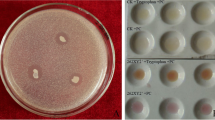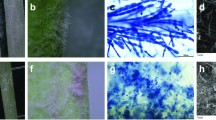Abstract
Entomopathogenic fungus is proposed to be one of the best biocontrol agents against the destructive insect pest Plutella xylostella. In this study, we tested the virulence of 11 Metarhizium strain isolates against P. xylostella using a leaf dipping method, and found one strain, named 609, which had displayed the highest pathogenicity. Bioassay results showed that the accumulated corrected mortality rate was 86.7 % on the eighth day after inoculation with a spore concentration 1 × 108 conidia/mL, and that the time to 50 % lethality was 5.7-day. The strain was identified as Metarhizium anisopliae var. acridum by internal transcribed spacer (ITS) region sequencing. A green fluorescent protein (GFP) marker containing vector, camben-gfp, was constructed and delivered into strain 609 by Agrobacterium tumefaciens-mediated transformation. Six positive clones expressing GFP were selected and tested for toxicity against P. xylostella, all of which displayed the same toxicity as the parental wild type strain. The survival rate of transformant T1 was investigated by monitoring GFP levels at 4-day intervals after inoculation into soil. We found that the concentration of Metarhizium spores decreased sharply from 1 × 107 conidia/g to 1 × 106 conidia/g in the first 5 days after inoculation. The decreasing trend then stabilized and the spore count declined to approximately 1 × 104–105 conidia/g after 1 month. The results of this study indicate that the expression of gfp gene in strain 609 does not alter the virulence capability of Metarhizium. This strain will therefore be useful for the control of P. xylostella and as a tool to study molecular biology properties and monitor colonization of M. anisopliae in the field.






Similar content being viewed by others
References
Bidochka MJ (2001) Monitoring the fate of biocontrol fungi. In: Butt TM, Jackson CW, Morgan N (eds) Fungi as biocontrol agents: progress, problems and potentia1. CAB International, Wallingford, pp 193–218
Bieliková L, Landa Z, Osborne LS, Curn V (2002) Characterization and identification of entomopathogenic and mycoparasitic fungi using RAPD-PCR technique. Plant Protect Sci 38(1):1–12
Cantone FA, Vandenberg JD (1999) Use of the green fluorescent protein for investigations of Paecilomyces fumosoroseus in insect hosts. J Invertebr Pathol 74:193–197
Cao Y, Peng G, He Z, Wang Z, Yin Y, Xia Y (2007) Transformation of Metarhizium anisopliae with benomyl resistance and green fluorescent protein genes provides a tag for genetically engineered strains. Biotechnol Lett 29:907–911
Casper SJ, Holt CA (1996) Expression of the green fluorescent protein-encoding gene from a tobacco mosaic virus-based vector. Gene 173(1):69–73
Chalfie M, Tu Y, Euskirchen G, Ward WW, Prasher DC (1994) Green fluorescent protein as a marker for gene expression. Science 263:802–805
Chen N, Hsiang T, Goodwin PH (2003) Use of green fluorescent protein to quantify the growth of Colletotrichum during infection of tobacco. J Microbiol Methods 53(1):113–122
Covert SF, Kapoor P, Lee M, Briley A, Nairn CJ (2001) Agrobacterium tumefaciens-mediated transformation of Fusarium circinatum. Mycol Res 105:259–264
Curran J, Driver F, Ballard JWO, Milner RJ (1994) Phylogeny of Metarhizium: analysis of ribosomal DNA sequence data. Mycol Res 98:547–552
Feilmeier BJ, Iseminger G, Schroeder D, Webber H, Phillips GJ (2000) Green fluorescent protein functions as a reporter for protein localization in Escherichia coli. J Bacteriol 182(14):4068–4076
Freimoser FM, Screen S, Bagga S, Hu G, St. Leger RJ (2003) Expressed sequence tag (EST) analysis of two subspecies of Metarhizium anisopliae reveals a plethora of secreted proteins with potential activity in insect hosts. Microbiology 149:239–247
Gassmann AJ, Carriere Y, Tabashnik BE (2009) Fitness costs of insect resistance to Bacillus thuringiensis. Annu Rev Entomol 54:147–163
Grzywacz D, Rossbach A, Rauf A, Russell D, Srinivasan R, Shelton AM (2010) Current control methods for diamondback moth and prospects for improved management with lepidopteran-resistant Bt vegetable brassicas in Asia and Africa. Crop Prot 29:68–79
Hu G, St Leger RJ (2002) Field studies using a recombinant mycoinsecticide (Metarhizium anisopliae) reveal that it is rhizosphere competent. Appl Environ Microbiol 68:6383–6387
Inglis PW, Aragao FJL, Frazao H (2000) Biolistic cotransformation of Metarhizium anisopliae var.acridum strain CG423 with green fluorescent protein and resistance to glufosinate ammonium. FEMS Microbiol Lett 191(2):249–254
Langfelder K, Philippe B, Jahn B, Latgé JP, Brakhage AA (2001) Differential expression of the Aspergillus fumigatus pksP gene detected in vitro and in vivo with green fluorescent protein. Infect Immun 69(10):6411–6418
Nakazato L, Dutra V, Broetto L, Staats CC, Vainstein MH, Schrank A (2006) Development of an expression vector for Metarhizium anisopliae based on the tef-1 alpha homologous promoter. Appl Microbiol Biotechnol 72(3):521–528
Roh JY, Choi JY, Li MS, Jin BR, Je YH (2007) Bacillus thuringiensis as a specific, safe, and effective tool for insect pest control. J Microbiol Biotechnol 17(4):547–559
Saiki RK, Gelfand DH, Stoffel S, Scharf SJ, Higuchi R, Horn GT, Mullis KB, Erlich HA (1988) Primer-directed enzymatic amplification of DNA with a thermostable DNA polymerase. Science 239(4839):487–491
Spellig T, Bottin A, Kahmann R (1996) Green fluorescent protein (GFP) as a new vital marker in the phytopathogenic fungus Ustilago maydis. Mol Gen Genet 252(5):503–509
St Leger RJ, Screen S (2001) Prospects for strain improvement of fungal pathogens of insects and weeds. In: Butt TM, Jackson CW, Morgan N (eds) Fungi as biocontrol agents: progress, problems and potentia1. CAB International, Wallingford, pp 219–238
Su Y, Nong X, Zhang Z (2012) Development and application of a specific SCAR marker for detection of a released Metarhizium acridum strain M189 in the field. Mycosystema 31(03):366–373
Sun J, Liang P, Gao X (2010) Inheritance of resistance to a new non-steroidal ecdysone agonist, fufenozide, in the diamondback moth, Plutella xylostella (Lepidoptera: Plutellidae). Pest Manag Sci 66(4):406–411
Talekar NS, Shelton AM (1993) Biology, ecology, and management of the diamondback moth. Annu Rev Entomol 38:275–301
Walker WH, Fitzpatrick SL, Barrera-Saldaña HA, Resendez-Perez D, Saunders GF (1991) The human placental lactogen genes: structure, function, evolution and transcriptional regulation. Endocr Rev 12(4):316–318
Ying SH, Feng MG (2006) Novel blastospore-based transformation system for integration of phosphinothricin resistance and green fluorescence protein genes into Beauveria bassiana. Appl Microbiol Biotechnol 72:206–210
Zhang L, Yang J, Niu Q, Zhao X, Ye F, Liang L, Zhang KQ (2008) Investigation on the infection mechanism of the fungus Clonostachys rosea against nematodes using the green fluorescent protein. Appl Microbiol Biotechnol 78:983–990
Acknowledgments
We thank Jianxiu Yao from Texas A&M University for her assistance in reviewing the manuscript and Zhihong Lang from Biotechnology Research Institute, CAAS for supplying reagents. This work was supported by the earmarked fund for China Agriculture Research System (CARS-35-07) and the Special Fund for Agro-scientific Research in the Public Interest (201003079).
Author information
Authors and Affiliations
Corresponding author
Rights and permissions
About this article
Cite this article
Cui, Q., Zhang, Y., Zang, Y. et al. Screening of high toxic Metarhizium strain against Plutella xylostella and its marking with green fluorescent protein. World J Microbiol Biotechnol 30, 2767–2773 (2014). https://doi.org/10.1007/s11274-014-1700-6
Received:
Accepted:
Published:
Issue Date:
DOI: https://doi.org/10.1007/s11274-014-1700-6




